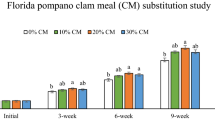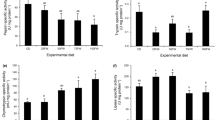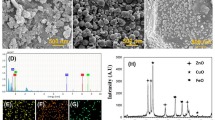Abstract
This study shows the effects of dietary activated charcoal (AC) on health status, intestinal morphology and fillet geosmin content of Nile tilapia prior to harvesting (2 and 4 weeks). Four dietary treatments (each diet in six replicates) were formulated to incorporate AC at levels of 0, 10, 20 and 30 g kg−1 of the dry diet. Fish were reared in hapas, which were located in earthen ponds. There were not significant differences in growth performances among experimental treatments. The moisture and protein content in the fillet decreased and increased, respectively, as the incorporation level of AC increased. The hematological indices and several immune parameters did not differ significantly among treatment groups. Among the fifteen blood chemicals parameters examined, the significant reductions in protein and cholesterol and the changes in blood minerals were observed in fish fed dietary AC ≥20 g kg−1. Dietary AC tended to increase the height of intestinal villi and goblet cell number. Dietary AC also influenced the reduction in geosmin in the fish fillet. Taken together, these findings indicate that AC (at 10 g kg−1 diet) could be used as feed supplement for Nile tilapia prior harvesting to reduce geosmin without negative effects.


Similar content being viewed by others
References
American Academy of Clinical toxicology (1999) Position statement and practical guidelines on the use of multi-dose activated charcoal in the treatment of acute poisoning. J Toxicol Clin Toxicol 37:731–751
AOAC (1990) Association of Official Analytical Chemists. Official methods of analysis of the Association of Official Analytical Chemists, vol 1, 14th edn. AOAC, Arlington, VA
Atkinson SW, Young Y, Trotter GA (1992) Treatment with activated charcoal complicated by gastrointestinal obstruction requiring surgery. BMJ 305:563
Awad WA, Bohm J, Razzazi-Fazeli E, Zentek J (2006) Effects of feeding deoxynivalenol contaminated wheat on growth performance, organ weights and histological parameters of the intestine of broiler chickens. J Anim Physiol Anim Nutr 90:32–37
Babson AL, Greeley SJ, Coleman CM, Philips GE (1966) Phenolphthalein monophosphate as a substrate for serum alkaline phosphatase. Clin Chem 12:482–490
Bacaoui A, Yaacoubi A, Dahbi A, Bennouna C, Phan Tan Luu R, Maldonado-Hodar FJ, Rivera-Utrilla J, Moreno-Castilla C (2001) Optimization of conditions for the preparation of activate carbons from olive-waste cakes. Carbon 39:425–432
Blomberg L, Krivan HC, Cohen PS, Conway PL (1993) Piglet ileal mucus protein and glycolipid (galactosylceramide) receptors specific for Escherichia coli K88 fimbriae. Infect Immun 61:2526–2531
Bracarense A-PFL, Lucioli J, Grenier B, Pacheco GD, Moll W-D, Schatzmayr G, Oswald IP (2012) Chronic ingestion of deoxynivalenol and fumonisin, alone or in interaction, induces morphological and immunological changes in the intestine of piglets. Br J Nutr 107:1776–1786
Bucolo G, David H (1973) Quantitative determination of serum triglycerides by the use of enzymes. Clin Chem 19:476–482
Cook D, Newcombe G, Sztajnbok P (2001) The application of powdered activated carbon for MIB and geosmin removal: predicting PAC doses in four raw waters. Water Res 35:1325–1333
Dacie JV, Lewis SM (2001) Practical haematology, 9th edn. Churchill Livingstone, London, p 633
Deng S (2006) Sorbent technology. In: Lee S (ed) Encyclopedia of chemical processing. Taylor & Francis Group, New York, pp 2825–2845
Doumas BT, Watson WA, Biggs HG (1971) Albumin standards and the measurement of serum albumin with bromcresol green. Clin Chim Acta 31:87–96
Edrington TS, Kubena LF, Harvey RB, Rottinghaus GE (1997) Influence of a superactivated charcoal on the toxic effects of aflatoxin or T-2 toxin growing broilers. Poult Sci 76:1205–1211
Flegg HM (1973) An investigation of determination of serum cholesterol by an enzymatic method. Ann Clin Biochem 10:79–84
From J, Hǿrlyck V (1984) Sites of uptake of geosmin, a cause of earthy-flavor, in rainbow trout (Salmo gairdneri). Can J Fish Aquat Sci 41:1224–1226
Galvano F, Pietri A, Fallico B, Bertuzzi T, Scire S, Galvano M, Maggione R (1996) Activate carbons: in vitro affinity for aflatoxin B1 and relation of adsorption ability to physicochemical parameters. J Food Prot 59:545–550
Gornall AG, Bardawill CJ, David MM (1949) Determination of serum proteins by means of the biuret reaction. J Biol Chem 177:751–766
Green JP, McCauley W (2006) Bowel perforation after single-dose activated charcoal. Can J Emerg Med 8:358–360
Hamilton RH (1966) A direct photometric method for chloride in biological fluids, employing mercuric thiocyanate and perchloric acid. Clin Chem 11:1–17
Hart LJ, Smith SA, Smith BJ, Robertson J, Holladay SD (1997) Exposure of tilapian fish to the pesticide lindane results in nypocellularity of the primary hematopoietic organ (pronephros) and the spleen without altering activity of phagocytic cells in these organs. Toxicol 118:211–221
Hrubec TC, Cardinale JL, Smith SA (2000) Hematology and plasma chemistry reference intervals for cultured tilapia (Oreochromis hybrid). Vet Clin Pathol 29:7–12
Kana JR, Teguia A, Mungfu BM, Tchoumboue J (2011) Growth performance and carcass characteristic of broiler chickens fed diets supplemented with graded levels of charcoal from maize cob or seed of Canarium schweinfurthii Engl. Trop Anim Health Prod 43:51–56
Kolf-Clauw M, Castellote J, Joly B, Bourges-Abella N, Raymond-Letron I, Pinton O, Oswald IP (2009) Development of a pig jejunal explant culture for studying the gastrointestinal toxicity of the mycotoxin deoxynivalenol: Histopathological analysis. Toxicol in vitro 23:1580–1584
Kumar N, Antony Jesu Prabhu P, Pal AK, Remya S, Aklakur Md, Rana RS, Gupta S, Raman RP, Jadhao SB (2011) Anti-oxidative and immune-hematological status of tilapia (Oreochromis mossambicus) during acute toxicity test of endosulfan. Pestic Biochem Phys 99:45–52
Kutlu HR, Ünsal I, Görgülü M (2001) Effects of providing dietary wood (oak) charcoal to broiler chicks and laying hens. Anim Feed Sci Technol 90:213–226
Li E, Lim C, Cai C, Klesius PH (2011) Growth response and resistance to Streptococcus iniae of Nile tilapia, Oreochromis nimoticus, fed diets containing different levels of wheat distiller’s dried grains with solubles with or without lysine supplementation. Anim Feed Sci Technol 170:246–255
Majewska T, Mikulski D, Siwik T (2009) Silica grit, charcoal and hardwood ash in turkey nutrition. J Elem 14:489–500
Matsui Y, Nakao S, Taniguchi T, Matsushita T (2013) Geosmin and 2-methylisoborneol removal using superfine powdered activate carbon: shell adsorption and branched pore kinetic model analysis and optimal particle size. Water Res 47:2873–2880
Mauel MJ, Miller DL, Merrill AL (2007) Hematologic and plasma biochemical values of healthy hybrid tilapia (Oreochromis aureus × Oreochromis nilotica) maintained in a recirculating system. J Zoo Wildl Med 38:420–424
McFarland AF, Chyka PA (1993) Selection of activated charcoal products for the treatment of poisonings. Ann Pharmacother 27:358–361
Mekbungwan A, Yamauchi K, Sakaida T (2004) Intestinal villus histological alterations in piglets fed dietary charcoal powder including wood vinegar compound liquid. Anat Histol Embryol 33:11–16
Moorehead WR, Biggs HG (1974) 2-Amino-2-methyl-1-propanol as the alkalizing agent in an improved continuous-flow cresolphthalein complexone procedure for calcium in serum. Clin Chem 20:1458–1460
Neuvonen PJ, Kuusisto P, Vapaatalo H, Manninen V (1989) Activate charcoal in the treatment of hypercholesterolaemia: dose-response relationships and comparison with cholestyramine. Eur J Clin Pharmacol 37:225–230
Olsen KR (2010) Activated charcoal for acute poisoning: One toxicologist's journey. J Med Toxicol 6:190–198
Phumyu N, Booanuntanasarn S, Jangprai A, Yoshizaki G, Na-Nakorn U (2012) Pubertal effects of 17α-methyltestosterone on GH-IGF genes of the hypothalamic-pituitary-liver-goandal axis and other biological parameters in male, female and sex-reversed Nile tilapia. Gen Comp Endocrinol 177:278–292
Pitaksong T, Kupittayanant P, Boonanuntanasarn S (2013) The effects of vitamins C and E on the growth, tissue accumulation and prophylactic response to thermal and acidic stress of hybrid catfish. Aquac Nutr 19:148–162
Piva A, Casadei G, Pagliuca G, Cabassi E, Galvano F, Solfrizzo M, Riley RT, Diza DE (2005) Activated carbon does not prevent the toxicity of culture material containing fumonisin B1 when fed to weanling piglets. J Anim Sci 83:1939–1947
Reif AE, Nabseth DC (1962) Serum amylase determination by Somogyi’s amyloclastic method with use of a photometric end-point. Clin Chem 8:113–129
Reitman S, Frankel S (1957) A colorimetric method for the determination of serum glutamic oxaloacetic and glutamic pyruvic transaminase. Am J Clin Pathol 28:56–63
Ridal J, Brownlee B, McKenna G, Levac N (2001) Removal of taste and odour compounds by conventional granular activate carbon filtration. Water Qual Res J Can 36:43–54
Rogosic J, Pfister JA, Provenza FD, Grbesa D (2006) The effect of activate charcoal and number of species offered on intake of Mediterranean shrubs by sheep and goats. Appl Anim Behav Sci 101:305–317
Ruttanavut J, Yamauchi K, Goto H, Erikawa T (2009) Effects of dietary bamboo charcoal powder including vinegar liquid on growth performance and histological intestinal change in aigamo ducks. Int J Poult Sci 8:229–236
Selim KM, El-hofy H, Khalil RH (2013) The efficacy of three mycotoxin adsorbents to alleviate aflatoxin B1-induced toxicity in Oreochromis niloticus. Aquac Int. doi:10.1007/s10499-013-9661-6
Siwicki AK, Anderson DP, Rumsey GL (1994) Dietary intake of immunostimulants by rainbow trout affect non-specific immunity and protection against furunculosis. Vet Immunol Immunopathol 41:125–139
Sunyer JO, Tort L (1995) Natural hemolytic and bactericidal activities of seabream, Sparus aurata serum are affected by the alternative complement pathway. Vet Immunol Immunopathol 45:333–345
Thu M, Koshio S, Ishikawa M, Yokoyama S (2010) Effects of supplementation of dietary bamboo charcoal on growth performance and body composition of juvenile Japanese flounder, Paralichthys olivaceus. J World Aquac Soc 41:255–262
Tucker CS (2000) Off-flavor problems in aquaculture. Rev Fish Sci 8:45–88
Vechklang K, Boonanuntanasarn S, Ponchunchoovong S, Ponchunchoovong S, Pirarat N, Wanapu C (2011) The potential for rice wine residual as an alternative protein source in a practical diet for Nile tilapia (Oreochromis niloticus) at the juvenile stage. Aquac Nutr 17:685–694
Villalba JJ, Provenza FD, Banner RE (2002) Influence of macronutrients and activated charcoal on intake of sagebrush by sheep and goats. J Anim Sci 80:2099–2109
Voigt GJ (2000) Hematology techniques and concepts for veterinary technicians. Iowa State University Press, Ames, p 139
Watson WA, Cremer KF, Chapman JA (1986) Gastrointestinal obstruction associated with multiple-dose activated charcoal. J Emerg Med 4:401–407
Weatherburn MW (1967) Phenol-hypochlorite reaction for determination of ammonia. Anal Chem 39:971
Wilson LL, Kurtz DA, Rugh MC, Chase LE, Zieglek JH, Varela-Alvarez H, Borger ML (1971) Effects of feeding activate carbon on growth rate and pesticide concentrations in adipose tissues of steers fed apple waste. J Anim Sci 33:1361–1364
Winsten S, Cehelyk B (1969) A rapid micro diazo technique for measuring total bilirubin. Clin Chim Acta 25:441–446
Yamprayoon J, Noomhorm A (2000) Geosmin and off-flavor in Nile tilapia (Oreochromis niloticus). J Aquat Food Prod Technol 9:29–41
Yoo JH, Ji SC, Jeong GS (2005) Effect of dietary charcoal and wood vinegar mixture (CV82) on body composition of olive flounder Paralichthys olivaceus. J World Aquac Soc 36:203–208
Acknowledgments
This study was supported by grants from the Suranaree University of Technology, the Higher Education Research Promotion and the National Research University Project of Thailand, Office of the Higher Education Commission, and the National Research Council of Thailand (SUT3-303-52-24-23). We acknowledge Mr. Sunai Plymee (SUT Farm) for maintaining the fish throughout this work.
Author information
Authors and Affiliations
Corresponding author
Rights and permissions
About this article
Cite this article
Boonanuntanasarn, S., Khaomek, P., Pitaksong, T. et al. The effects of the supplementation of activated charcoal on the growth, health status and fillet composition-odor of Nile tilapia (Oreochromis niloticus) before harvesting. Aquacult Int 22, 1417–1436 (2014). https://doi.org/10.1007/s10499-014-9756-8
Received:
Accepted:
Published:
Issue Date:
DOI: https://doi.org/10.1007/s10499-014-9756-8




